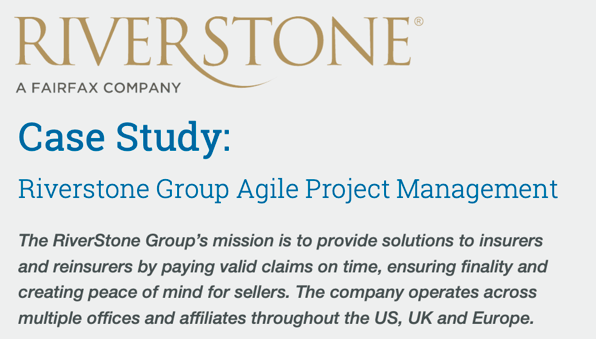Overview
In this paper:
-
Learn how the shift from traditional, linear portfolio management to Agile Portfolio Management has organizations delivering projects more quickly and adapting to changing requirements faster.
-
Understand three ways to embrace Agile Portfolio Management practices through an automated project portfolio management (PPM) solution to give your PMO the visibility needed to make informed strategic decisions.
-
Discover how Agile Portfolio Management allows PMOs to centralize the execution of multiple project methodologies and custom workflows.
Want to equip your Project Management Office (PMO) with the tools to deliver high value at speed to your customers, while properly managing resources, investments and capacity? It’s time to shift to Agile Portfolio Management. Today’s rapidly evolving digital economy requires every organization to continuously provide solid value, accelerated delivery and flawless customer experience (CX). Agile Portfolio Management allows PMOs to break free from the limitations of linear, sequential management practices by applying Agile principles – such as breaking up work into short-duration sprints, delivering product quickly and continuously, and swiftly adapting to changing customer requirements – to the top-down portfolio decision-making.
Too often, enterprises find potential wins and successes hampered by outdated portfolio management methodologies, which lack the flexibility to address sudden changes in the market and emphasize meeting budgets and deadlines rather than customer expectations. For these organizations, Agile methodologies are usually only leveraged at the execution level, among software developers and other technical teams. Program- and portfolio-level decision-making — encompassing capacity, investment, skillset requirements, forecasting and resource allocation — is still a largely manual process done in spreadsheets and time-consuming team meetings.
This outdated approach to portfolio management has exposed several common pain points felt by most PMOs and portfolio managers, which inhibit their effectiveness:
-
The high cost of making the wrong investments – Without effective portfolio management and capacity planning, “organizations tend to overestimate the amount of capacity available in their resource pool and overcommit resources for pending projects and programs.” Doing so, despite a lack of resources, “can actually extend the end date of a four-month project to as much as a year” (Resource Capacity Planning for PPM Leaders, Gartner, February 2018).
-
The need to deliver faster – A recent Gartner survey found that the #1 driver for adopting more Agile methods of portfolio management is a desire to deliver strategic projects faster. The report goes on to say, “Business teams’ frustration with slow delivery by the IT department is a powerful motivator” (Survey Analysis: IT Is Moving Quickly From Projects to Products, Gartner, October 2018).
-
The urgency to create business value – In the past, technology investments or other company-wide projects could be made based solely on the technical merits or functional requirements of a particular solution, with delivering a project on time and on budget being a measuring stick of benefit unto itself. Those days are gone. Today, strategic projects and programs must be couched in the value they deliver to the business.
Making the shift to Agile Portfolio Management can curb these pain points, resulting in multiple benefits.
1) Faster response to changing priorities- The challenge of traditional portfolio management, typically based on an annual budget cycle, is it provides no flexibility to adapt to the market
or organizational changes that will inevitably come. In Agile Portfolio Management, investments are made on an iterative basis, based on the value each initiative is delivering to the business.
2) Improved delivery of strategic projects
-
Speed is definitely the cornerstone of the digital economy. If you’re not delivering quickly, chances are your competition is waiting to fill in the gap. The combination of an Agile approach to portfolio management and an effective PPM tool allows PMOs to quickly identify the most valuable projects and prioritize investments and resources to ensure those high-value initiatives are delivered faster.
3) Accurate resource capacity planning
-
Without effective capacity planning, Agile Portfolio Management is impossible, because investments and resources can’t be adjusted if there’s no visibility into how those resources are being used today or when they’ll be available to take on more work. With Agile Portfolio Management, which leverages accurate capacity planning, PMOs can shift resources in real-time while simultaneously planning for future deliverables. Hidden projects become a relic of the past and surprises are minimized. Of course, when the rare surprise does occur, your Agile team can move swiftly to correct the situation with minimal disruption.
-
CX is stressed over and over for a reason. A recent Gartner report notes that it’s critical to overall success and profitability. Customers expect quality, speed and dedication. And for the PMO, its customers are the stakeholders and business units it serves. With an emphasis on continuous delivery, Agile Portfolio Management shifts the focus from project start and end dates to the ongoing delivery of value that customers can trust, which in turn leads to happier, more engaged stakeholders.
Part Two: Why Use KeyedIn for Agile Portfolio Management?
Making the shift to Agile Portfolio Management requires support from a trusted partner with expertise in minimizing disruption and easing the transition. After all, a shift in methodology is intimidating for every organization. It comes with questions and concerns that must be addressed in order to be effective: Where do we start? How will this new methodology be facilitated? How will the PMO adjust to it? How do we know it’s working?
KeyedIn Projects (KIP) can help organizations embrace Agile Portfolio Management by enabling three key capabilities that form the foundation of this innovative approach:
1) Deliver products instead of projects.
-
A project delivery approach is finite, with a series of tasks and an end date. It limits room for growth and improvement and is slow to react to change. The end focus is simply fulfilling a requirement, not delivering value to the customer. The KeyedIn emphasis on implementing a product delivery approach means that efforts focus on continuous delivery and growth — and the ongoing value to the customer is always top of mind. Investment and resources adapt quickly to achieve rapid delivery, with a backlog of projects standing ready to spring into motion immediately.
- An Agile approach to PPM must encompass all project types – Waterfall, Agile and custom workflows – within the same portfolio. Remember, the key to being Agile is flexibility and that includes adapting outward to embrace
all projects types or even custom workflows with the focus on results rather than procedures. Through centralization, KeyedIn can help your PMO have the power to view all projects under the portfolio at the same time, investing resources, adjusting priorities, and adapting plans accordingly.
3) Implement the concept of continuous improvement.
-
Remember to old adage “always be closing”? It refers to the idea that a truly stellar salesperson should always have the close on his or her mind. That same dedication should be applied to improvement under an Agile Portfolio Management methodology. With annual plans being replaced by iterative planning, there are multiple opportunities to shift focus, investment and activities. How do you measure if those shifts have resulted in improvement? KeyedIn recommends measuring each step in the planning process and adjusting as inefficiencies are identified. This approach requires setting key performance indicators and measuring them via dynamic reporting powered by digital reporting tools in your PPM solution or an external business intelligence tool.
Part Three: Success Stories: Conquering the Shift to Agile Portfolio Management

- No transparency into project/product operations, making it very difficult for business leaders to tie individual initiatives back to the broader product roadmap.
- Needed to move to a product-centric model that goes beyond start and end dates to manage a product lifecycle from inception to sunset.
- Little visibility into a portfolio that includes numerous project types and workflows, including software development work being executed in Jira.
- No capacity planning to determine how much work a team could accommodate.
- Lengthy delays in the approval process for new products.
Customer Benefits
- Agile Portfolio Management allows the Riverstone team to accommodate many project types and workflows to identify the company’s top 10 initiatives that will deliver the most value to the business.
- Company executives have full transparency into product operations and the expected benefits of each initiative.
- Accurate visibility of resource capacity and utilization, allowing leadership to understand what each team is working on and when they can take on more work.
- Stakeholders can easily identify and correct bottlenecks in the product workflow and approval process with native KeyedIn Projects reports and integration with Microsoft PowerBI.
Why KeyedIn
- Competence and expertise
- Develops KIPs to match unique requirements
- Product flexibility in accommodating multiple project types
- Strong integration with Jira and TFS
- Project/product prioritization based on business value and strategic alignment
- Track benefits realized instead of just dates, deadlines and tasks
- Plan capacity using complete and accurate data for resource availability and skill sets

Pains Prior to KeyedIn Support for Agile Portfolio Management
- No consistent global reporting across project management disciplines.
- An inability to manage multiple project types and workflows within a single portfolio, leading to limited visibility and poor resource management.
- No ideal platform from which to implement a company-wide initiative around the Scaled Agile Framework (SAFe).
Customer Benefits
- KeyedIn Projects provides a single unified platform for project portfolio management: Project execution happens in Jira and TFS, with all approvals, work and financial tracking and reporting in KeyedIn.
- KeyedIn enables improved control, visibility and an audit trail across the portfolio, independent of methodology.
- The Agile Portfolio Management capabilities of KeyedIn Projects have allowed this financial services giant to transition key elements of the company’s operations to SAFe.
Why KeyedIn
- Strong onsite demo
- The product’s flexibility in accommodating multiple project types
- Strong integration with Jira
- Visibility to every project/product in the portfolio, regardless of the work methodology being used (including integration with Agile tools like Jira, TFS, etc.)
- The ability to model portfolio scenarios to find the ideal mix to deliver optimal value
Conclusion
It is possible to adapt and deliver the highest value to your customers and stakeholders by changing from traditional, linear portfolio management methods to Agile Portfolio Management. Agile Portfolio Management with KeyedIn’s scalable PPM solution and capable implementation team empowers your PMO to manage resources, investments and capacity effectively while simultaneously focusing on fast delivery, continuous improvement and customer satisfaction.
KeyedIn Projects is a supremely flexible solution for managing projects, programs and entire portfolios – from a single platform that provides a comprehensive view of the status of every project. Used by project managers, boardroom decision-makers, and frontline users, KeyedIn Projects increases success rates and profit margins, enables better decisions about project selection, planning, and prioritization and optimizes resource usage across the entire business. Headquartered in Minneapolis, KeyedIn has hundreds of customers worldwide, including Walgreens Boots Alliance, LexisNexis and Office Depot.



